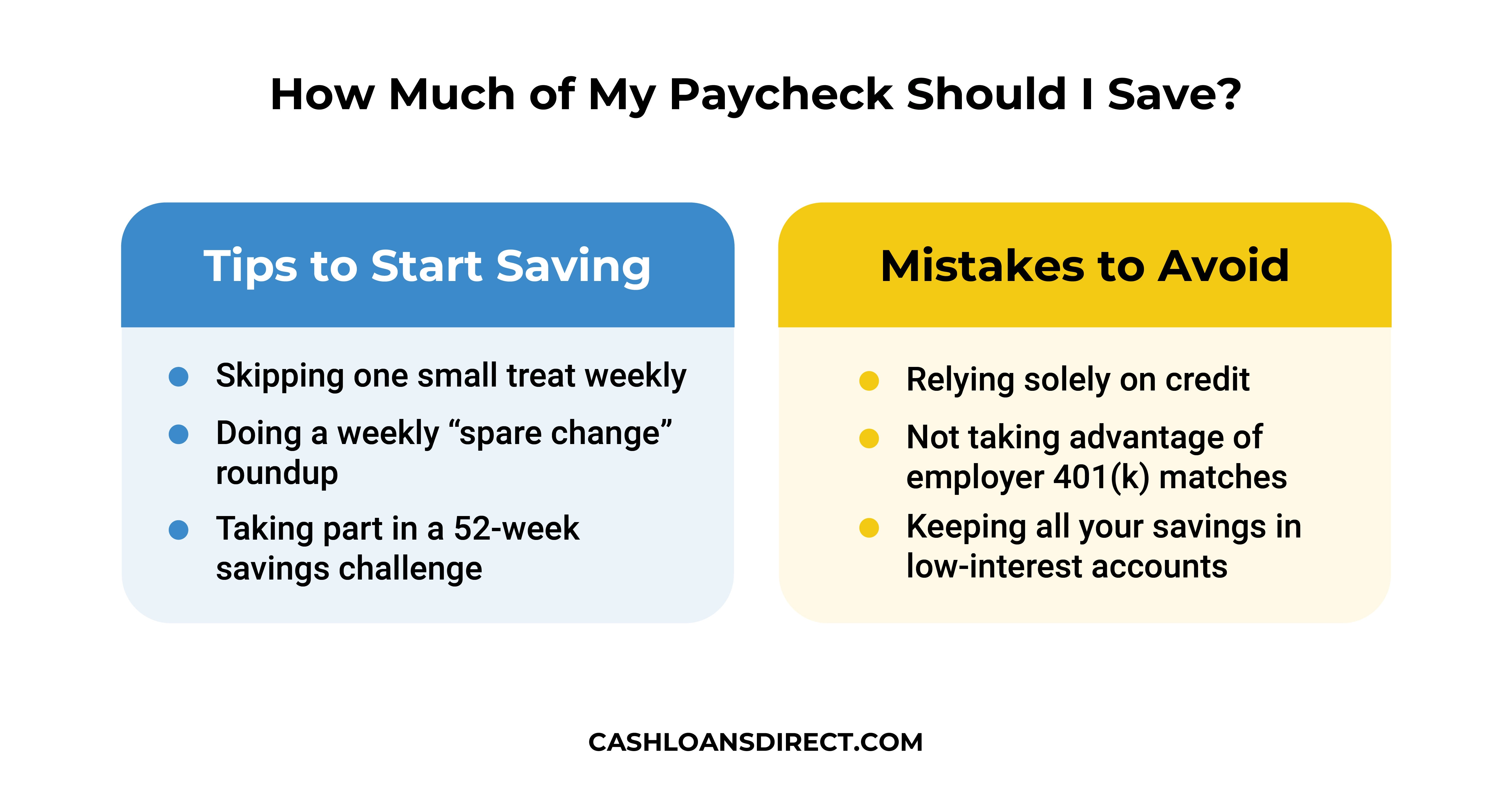texas
How Much of My Paycheck Should I Save?
Learn saving guidelines and budgeting strategies to maximize your paycheck.

When you get paid, how much do you put toward your bills? How much do you move to your savings account? These are questions you likely consider from time to time, wondering if you’re doing it right.
Saving a portion of each paycheck isn’t just about building a rainy-day fund—it’s about creating a sense of stability for your future. Whether you’re working toward a big goal like buying a home, preparing for emergencies, or simply hoping to enjoy a less stressful financial life, setting money aside regularly can make a big difference.
In this article, we’ll walk you through some common guidelines for how much of your paycheck to save, how to break your income into workable spending categories, and smart budgeting strategies that can help you stay consistent—even when your expenses feel tight. Let’s take the guesswork out of saving.

The 50/30/20 Rule
Deciding how much you should save from each paycheck starts with taking a look at your budget overall. By looking at your budget holistically, you can better determine if you are living within your means or if you’re taking on more than you can financially bite off.
One popular method for budgeting is the 50/30/20 rule. It breaks down your take-home pay into three general categories:
- 50% for needs: This includes rent or mortgage, groceries, utilities, transportation, insurance, and minimum debt payments—basically, everything you must pay for to keep life running.
- 30% for wants: Going out to eat, a night at the movies, subscriptions, hobbies—these are expenses that bring enjoyment but aren’t essential.
- 20% for savings and debt repayment: This portion goes toward building your savings, paying down extra debt, or contributing to an emergency fund or retirement account.
For some people, especially those with lower incomes or high fixed expenses, this breakdown may not be realistic. In those cases, adjusting the percentages—such as a 60/10/30 or 70/10/20 split—can help create a plan that still prioritizes saving, even if in smaller increments.
No matter your income, setting aside money for emergencies is a smart move. Experts often recommend building an emergency fund that covers three to six months of essential expenses. This cushion can help you weather unexpected bills, job changes, or medical issues without turning to high-interest loans or credit cards. Starting with even a few hundred dollars can make a big difference—and that’s where a consistent saving habit, even if small, really pays off.
Tips to Start Saving
Though the goal is to set aside 20% of your paychecks toward savings and paying down extra debt, you might not be able to make that happen right off the bat. That said, even putting a small amount aside each day can really add up, and it’s a great way to get started.
Start by calculating your monthly take-home pay—that’s your income after taxes, health insurance, and other deductions. If you’re paid biweekly, multiply one paycheck by two. If you’re paid weekly, multiply by four. Knowing your exact take-home income makes it easier to create a savings plan that works for your current situation.
Automate your savings whenever possible. Set up an automatic transfer to a savings account each payday. This way, saving happens in the background without you needing to think about it—and you’re less tempted to spend it.
There are also several tools that can help simplify the process. Budgeting apps like Mint, You Need a Budget (YNAB), and Goodbudget let you track your spending, set savings goals, and monitor your progress. Some apps, like Qapital or Acorns, use creative strategies like rounding up your purchases and moving the spare change into savings.
If you’re starting from behind, don’t get discouraged. Try micro-saving techniques like:
- Skipping one small treat per week (like a $5 coffee) and transferring that amount to savings.
- Doing a weekly “spare change” roundup and moving it into a separate account.
- Taking part in a 52-week challenge, where you increase your savings by a small amount each week.
Little by little, those small deposits grow—and so does your confidence in your ability to save.
Common Mistakes to Avoid
Saving isn’t always easy, and the numbers reflect that. According to recent surveys, 42% of Americans don’t have enough savings to cover a $400 emergency, and 37% say they couldn’t afford an emergency expense of that amount at all. Even more concerning, 22% of U.S. adults report having no emergency savings whatsoever.
If you’re working to improve your financial situation, it helps to know what pitfalls to watch for. Here are a few common missteps people make when starting to save:
- Relying solely on credit instead of saving: Credit cards can help in a pinch, but leaning on them for every emergency can quickly lead to debt that’s hard to pay off. Building even a small emergency fund can offer better peace of mind without the high interest.
- Not taking advantage of employer 401(k) matches: If your employer offers a 401(k) match and you’re not contributing enough to get the full benefit, you’re leaving free money on the table. Contributing just enough to receive the match is an easy way to start saving for retirement.
- Keeping all your savings in low-interest accounts: It’s smart to keep emergency funds in an easily accessible account, but any long-term savings goals might benefit from a high-yield savings account or other interest-bearing options. Let your money work for you over time.

Start Saving Today
Building a savings habit takes time, planning, and a little patience—but it’s well worth the effort. We’ve talked about the answer to the common question, “how much should I save from each paycheck?” We looked at how the 50/30/20 rule can guide your budget, shared tips for getting started even if you’re behind, and pointed out common savings mistakes to avoid.
If unexpected expenses are making it harder to stay on track, Cash Loans Direct maintains a partnership(s) with a third party direct lender(s) to facilitate safe and secure loans to help cover short-term needs while you continue working toward your financial goals.
Ready to take the next step? Apply now with Cash Loans Direct and start building the savings habits that support a more stable financial future.
Are you ready to apply?
Click Apply Now to complete our easy online loan application and instantly receive your loan decision.




